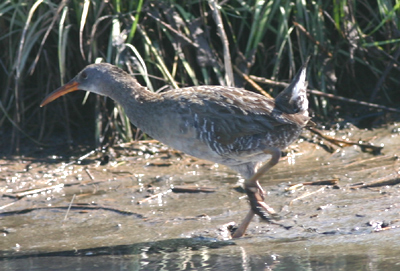
Photo From
sdakotabirds.com
I went on the New York State Young Birders Club trip to th Muttontown Preserve on Long Island. Since I wrote the trip report, and I don't want to write the same thing twice, here is my report. I had 2 lifers: Chestnut-Sided and Blue-Winged Warblers. That brings me to 2 birds away from 250.
We arrived and met in the parking lot of the Muttontown Preserve, in Nassau County, at 7:45. Already it was warm, and the weather would prove to be great for the whole morning. There were seven young birders there, including three that had joined recently, making this one of the best young birder turnouts yet. Our leaders were Brent Bomkamp and Stella Miller. A few catbirds were in the bushes bordering the parking lot, and a group of Chimney Swifts swooped overhead, twittering constantly. After visiting the center (or more accurately, the bathrooms), we set off. A Wood Thrush was quickly heard, though it did not show itself. That would be the case with many of the birds we located, and a significant amount of the birding was done only be ear. A Blackpoll Warbler was heard, but it, frustratingly, kept hidden as well.
Our first hotspot came only about 15 minutes into the walk. We were hearing the blackpoll, and also saw multiple yellow warblers, a redstart, a red-eyed vireo, and, the best bird, a chestnut-sided warbler. Both the redstart and chestnut-sided gave good looks to some. A veery was also singing its beautiful song. It was a great start to the day, and still barely 8:00.
Much of the sightings of the day would be around a number of fields on the preserve. We came to the first one hearing Blue-Winged Warblers, and eventually found them, as well as an Eastern Towhee and a few yellowthroats. Soon after a grosbeak was spotted and stayed in the open, giving all birders a chance to see it. At another field we saw a House Wren in a nest box and a brown thrasher.
Many good birds were found in the trees adjoining another large field. There we found Baltimore Orioles, Blue-Winged Warblers, Indigo Buntings, waxwings, yellowthroats, and a flyover Red-Tailed Hawk. One of the rarest, but most annoying birds of the day was found here too. Someone heard a White-eyed Vireo, and we all looked up into the large tree that it was in. And we looked, and looked, and did not find it. We even spent a couple minutes looking at the field itself after a bird, which turned out to be a yellowthroat, flew from the target tree down into the grass. We then went to the other side of the tree, and there a few people got mediocre looks, and one or two got good looks. While accomplishing this we realized that Vireo-neck can be just as bad as warbler-neck, and this time your quarry doesn’t move, so you don’t know where it is. When we were satisfied that enough people had seen it, we moved on.
Another surprise came at a different field, when an American Woodcock flushed from the meadow into the woods. At another wooded spot, we found a grosbeak that stayed right in the open very close to us, giving us great looks. We also heard a Magnolia Warbler and a Scarlet Tanager. Other heard-only birds included a kingbird and wood-pewee at different times.
At one point, Brent, being the great leader that he was, taught us a very important lesson about birding- Be careful when looking up into a tree. At one point, we were walking along a wooded section of the trail, and heard a loud rustling sound directly above us. Brent looked up… and, well, you can probably tell where this is going. As to the species, (the first thing we inquired about) it was a robin. We decided that it was supposed to be good luck, though unfortunately that luck did not manifest itself in the form of a cuckoo sighting. (We decided that the luck could have be that nothing got on his new jacket.)
After this we began to head back to the visitor center, seeing a Veery, Mallards, and bizarre bathtub-like things filled with charcoal. That was somewhat puzzling. Before we reached the center, we also found a pair of towhees that were almost certainly nesting, and a red-eyed vireo. A brief stop to try to locate a cuckoo failed. At the center again, we found a Red-Tailed Hawk and another hawk that might have been red-shouldered, swifts, and a nesting Carolina Wren in a vent in the side of the center. After the wren left, we also saw a female cowbird visit the same nest. A few Double-Crested Cormorants flew over as well. After talking for a bit, we departed after a great trip. The total for the day was 47 species, even without House Sparrow, Starling, and Rock Pigeon.
Thank you to Stella Millar and Brent Bomkamp for leading the trip, and the Huntingdon Audubon Society, our partner organization that sponsored it.
 (From 10000 birds- a great birding site/blog)
(From 10000 birds- a great birding site/blog)
